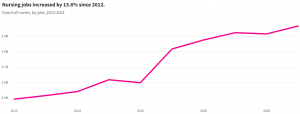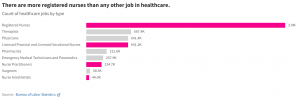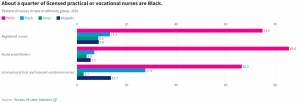Almost four million nurses work in the US healthcare system, equal to one in every 85 Americans. Nurses work in doctor’s offices, hospitals, nursing homes, long-term care facilities, and more. There are more nurses than in any other occupation within the healthcare industry.
While nurses tend to make a higher annual salary than other jobs, it’s a demanding occupation, with long shifts and stressful situations.
On top of the usual demands of the profession, the COVID-19 pandemic added unique pressure to America’s nurses. The critical needs of the healthcare system during the pandemic meant nursing employment rose while other occupations lost jobs over that time.
How many nurses are there in the US?
According to data from the Bureau of Labor Statistics, as of 2021, there were 3.9 million nurses in the US. From 2012 to 2021, the number of nurses in the US grew by 13.6%. That’s faster than the 8.1% increase in jobs for the overall workforce.
Nursing jobs are not all the same. Government data breaks down the field into a few distinct categories.
The largest category is registered nurses. They help assess patient health conditions, provide medical care, track medical records, and advise patients on their health, among other services.
About three million registered nurses are employed in the US, 57% of whom work in hospitals.
The next largest category of nurses is licensed practical nurses and licensed vocational nurses. These nurses care for ill, injured, or convalescing patients in various settings. They often work under the supervision of a registered nurse and require licensing.
There are about 641,000 licensed practical nurses and licensed vocational nurses in the US. Nursing care facilities employ 209,440 of these types of nurses, more than any other industry.
Nurse practitioners work independently or as part of a medical care team. They can order and perform medical tests and can interpret the test results. They also can prescribe medication. Nurse practitioners must receive special education and training, in addition to being a registered nurse.
About 235,000 nurse practitioners are employed in the US. Forty-seven percent of nurse practitioners work in doctor’s offices.
Nurse anesthetists provide anesthesia to patients and monitor their care. These nurses assist anesthesiologists, surgeons, dentists, and other doctors. In addition to being a registered nurse, nurse anesthetists need specialized education.
There are about 44,000 nurse anesthesiologists in the US. About 53% work in doctor’s offices and hospitals.

How diverse is the nursing profession in the US?
A higher percentage of nurses are women compared to all workers in the US, according to the 2021 Current Population Survey from the BLS.
About 87% of registered nurses, nurse practitioners and nurse anesthetists are women, as are more than 90% of licensed practical nurses and licensed vocational nurses. That share is higher than the 47% of the overall workforce that are women.

About three-quarters of registered nurses are white. This figure is on par with the percentage of white workers in the US overall.
Nurse practitioners are about 87% white, compared to 78% of the US workforce. Licensed practical nurses and licensed vocational nurses are about 28% Black, while the total workforce is 12% Black.

According to a 2018 Health Resources and Service Administration Survey, the average age of a registered nurse is 50, but more than half of nurses are younger than that.
How much money do nurses make?
Nurses make more annually than the national average wage, according to BLS data. For 2021, the average wage for registered nurses was $82,750, compared to the national average for all occupations of $58,260.
Nurse anesthetists make the most of any nursing category with an annual average wage of $202,470.
Licensed practical nurses and licensed vocational nurses make the least of any nursing category, with an annual average wage of $51,850.

source: https://usafacts.org/articles/who-are-the-nations-nurses/